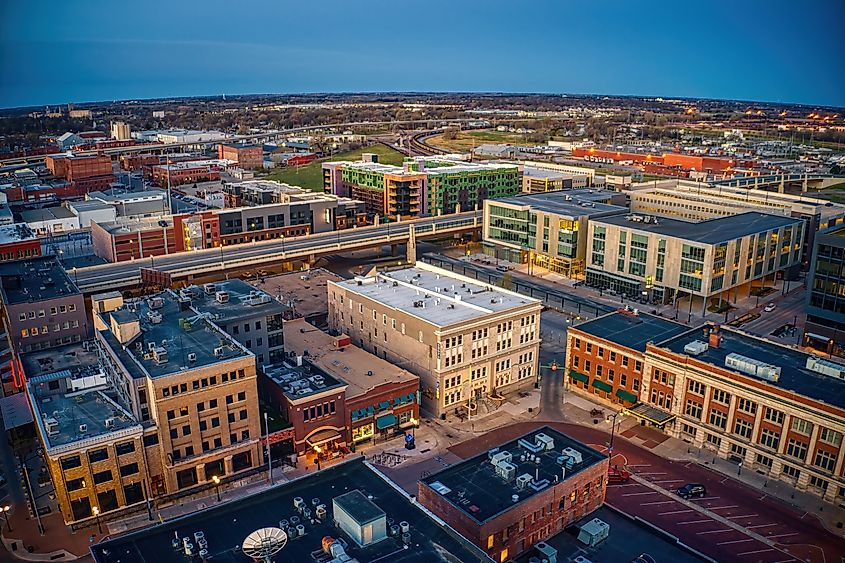
Scott J. Scheef, CPA, CVA
Partner
Tax Increment Financing (TIF) is a funding mechanism for development, most commonly within urban areas. Through this article, we will highlight the background of TIF, how it is utilized in Nebraska, income taxability of projects, and potential drawbacks of TIF projects.
What is Tax Increment Financing (TIF)?
Tax Increment Financing (TIF) has emerged as a cornerstone of urban revitalization and economic growth in many urban areas, including cities like Lincoln and Omaha. TIF was established in Nebraska following the 1975 enactment of the Community Development Law and reinforced by subsequent constitutional amendments. Its purpose is straightforward, yet extremely effective – the incremental property tax increase after a development or redevelopment is allocated to the repayment of the cost incurred by the developer. TIF is a public financing tool utilized by cities or local governments to encourage development or redevelopment in a specific area—often one that’s underdeveloped, blighted, or in need of economic stimulation.
How Does It Work?
The process begins with a local government establishing a geographic area where it would like to spur growth. The base for the property taxes allocated to the general fund for the designated parcels is then frozen for a specified duration (typically 15-20 years). This allows private developers to improve the property, and as assessed values in the area increase, the “increment” is established. This increment is the difference between the taxes based on the new, higher property tax assessments and the frozen base value. With the property’s TIF designation, the local government then diverts the incremental tax revenue from the general tax fund to pay for the development-related costs. Upon the expiration of the aforementioned pre-established period, the property’s tax base is reset to the current assessed value, and the higher property tax revenues flow into the general tax fund to benefit the community.
For example, a parcel qualifying for TIF has an original tax base of $50,000 and generates roughly $1,000 per year in taxes. After the parcel is qualified as a TIF property and development is completed, the tax base is increased to $550,000 and generates roughly $11,000 per year in taxes. The increased tax after development of $10,000 per year is then directed to repayment of the TIF bonds. After the expiration of the TIF’s frozen period, the additional tax is then returned to the general fund annually.
TIF can be used in multiple stages of development and redevelopment, typically for site acquisition and demolition, infrastructure (streets, utilities, etc.), preservation of historic areas, energy-efficient improvements, and affordable housing projects.
In Nebraska, Who is Eligible for TIF Projects and How to Get Started?
The process with TIF projects varies by city and even project. Below is some information specifically to Lincoln and Omaha.
Lincoln has two categories:
- “Core Area” Projects – Core projects are those within the city limits as of 1970. These projects receive priority for reinvestment, historic preservation, housing, and community revitalization.
- “Outer Area” Projects – Projects that emphasize areas outside the 1970 city limits that are unimproved, peripheral zones. The key priority of these projects is those that grow infrastructure, increase primary employment, or improve access to housing.
All projects must also pass a “but for” test – meaning they need to illustrate that the development would not take place “but for” the use of TIF funding. Additional emphasis is added on affordable housing and sustainability.
Omaha’s TIF program mirrors Lincoln’s in structure but has its own focus areas:
- Job creation in high-need areas
- Adaptive reuse and infill housing
- Mixed-use development tied to workforce housing
- Historic revitalization
Omaha distinguishes between “Entry Level TIF” (projects $250,000–$500,000, 10-year term) and “Next Level TIF” (over $500,000, 15–20 year term) tiers. It emphasizes community outreach for public feedback, sustainable design, and thorough review via its 9-member TIF Committee.
How are TIF Project Funds Taxed for Income Tax Purposes?
How TIF benefits are taxed for income tax purposes can depend on the funding and structure of the project. While TIF is repaid by diverting real estate tax revenues, it isn’t a tax itself; rather, it is a financing tool. This causes a need to understand the underlying transaction before establishing the income tax treatment.
Generally, TIF funds received by a developer or real estate investor are considered taxable. It is also taxable if the payment was used for capital improvements to property used directly in your business. One potential exemption from income tax is reimbursement for public infrastructure (sidewalks, utilities, etc.).
The taxability of TIF funds for a developer or real estate investor can be complicated, and special determinations are necessary prior to utilization of the TIF project. We recommend you consult with a TIF expert to discuss the taxability prior to entering into a TIF agreement.
Finally, another impacted beneficiary of TIF projects is bondholders and investment brokers. In these scenarios, bond interest taxability can vary on both the federal and state levels. We recommend that all individuals seeking to invest in TIF bonds consult with a tax and/or investment advisor prior to purchasing bonds.
What are the Potential Drawbacks of TIF Projects?
Tax Increment Financing can be a powerful development tool with numerous public benefits, but it’s also one of the more controversial forms of public financing. Primary public concerns are that the bonds’ success hinges on estimates of the incremental value, that funds are not only used in blighted areas, and that the delay in community benefit can add strain to other public services.
Final Thoughts
TIF projects are an incredible tool utilized by local governments to spur reinvestment of funds into projects that benefit their residents. It empowers cities and encourages local governments and developers to focus on blighted and underdeveloped areas for thriving urban growth.
While projects are a wonderful asset for cities and area developers, the complexity of the policies can require engagement of professionals with backgrounds specific to these types of projects. If you are interested in learning more about the mechanics of TIF projects, please do not hesitate to reach out to our experts at HBE LLP for assistance.
Resources:
https://planninghcd.cityofomaha.org/tif
https://www.lincoln.ne.gov/files/sharedassets/public/v/1/urban-development/redevelopment/tif-policy-revised-2022-final.pdf
https://www.lincoln.ne.gov/files/sharedassets/public/v/1/urban-development/redevelopment/tif-101-final-formatted.pdf




